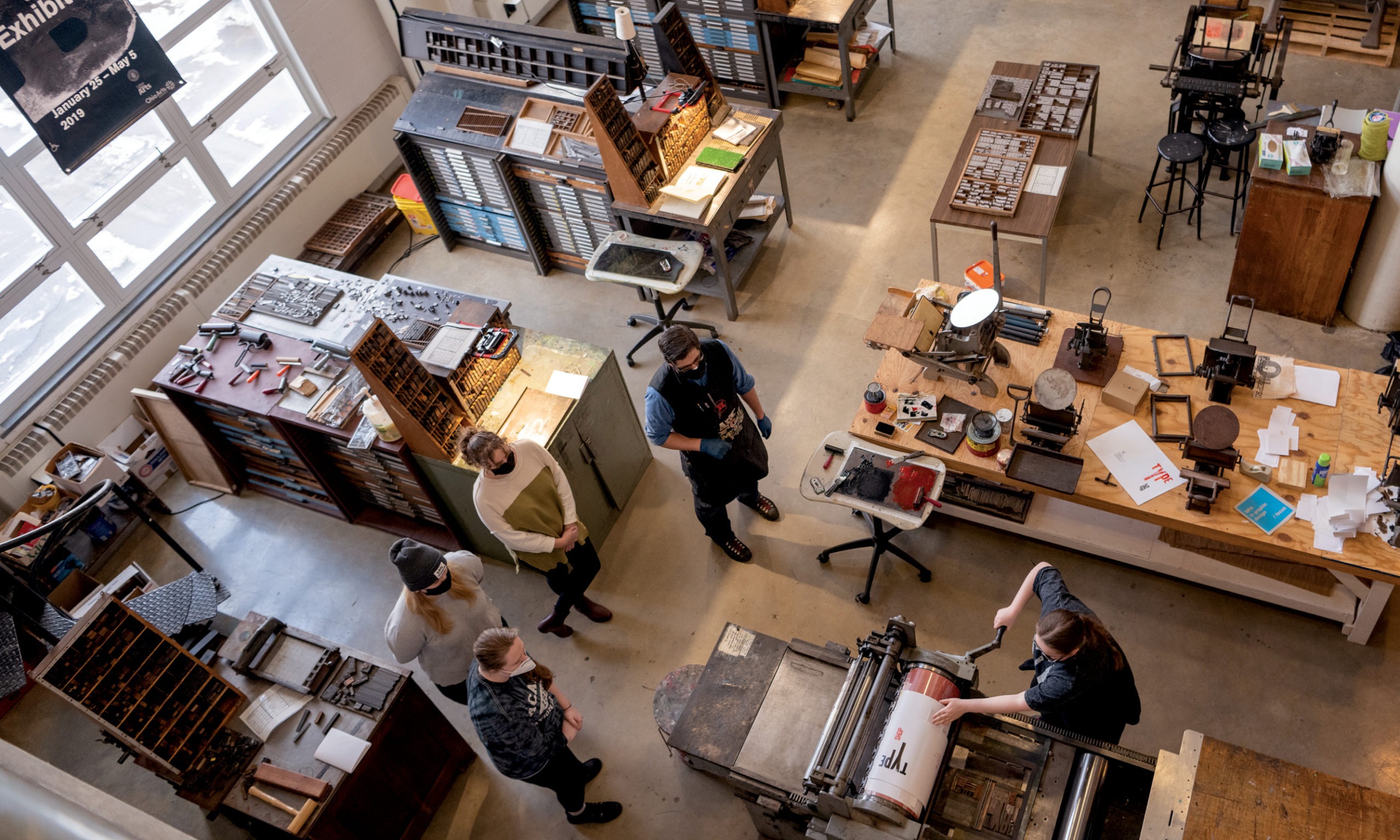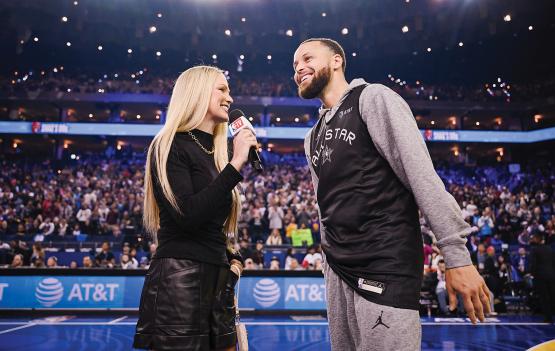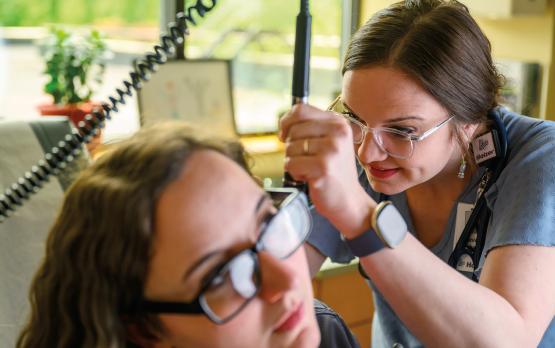
A bespeckled professor bends over a massive, mysterious contraption. Open drawers reveal hundreds of metal and wood blocks. He rolls out the ink before applying it to type methodically set in place, letter by letter. He kisses paper to that very ink, creating a lasting impression.
Welcome to the Don E. Adleta TypeShop and Bindery, where printing processes and instruments of the past breathe new life and meaning into “words of art”—and fuel the creative minds of the future.
This newly dedicated 900-square-foot space in Seigfred Hall 222 houses a historical bounty—restored 19th- and 20th-century presses, platen presses, a complete bindery—all of it donated. Its library offers 400-plus drawers of metal and wood type, with replicas of fonts dating back to the 1500s, and revived metal castings created by Assistant Professor Darren Baker, MFA ’12.
“I can’t imagine a better legacy … than helping preserve this space and the activities it promises,” says Professor Emeritus of Graphic Design Don Adleta, BFA ’75, who retired in 2021 but remains involved in the TypeShop and Bindery named in his honor. Through the establishment of a charitable remainder unitrust benefitting The Ohio University Foundation, Adleta will provide future support for capital improvements to the College of Fine Arts’ facilities and create the Adleta/Toner Endowment for the Preservation of the Printed Word and Book Arts, which will sustain his OHIO namesake for years to come.
The space pays tribute to Adleta’s OHIO and graphic design legacies and his work—alongside colleagues past and present—to preserve the traditions of the printed word and create a hands-on learning environment. For Adleta and Baker, this new space does much more than preserve history; it trains a deeper, felt sense of design concepts, processes and aesthetics.
“When studying modern languages, you can immerse yourself abroad. That is what we’re doing,” Adleta says. “You can’t send a student into a computer screen, but you can open a drawer; take out letterforms and bind them; press ink onto paper to create a word, an image, a message … Students apply sharper focus on design essentials here compared to the digital space.”
Graphic design MFA student Daniel Asamoah Opoku from Ghana calls it “a physical interaction with type. Instead of moving it around on the screen, you are touching it. You’re speaking to it—and it’s also speaking to you.”
Decades in the making
It all began in the 1970s, when Adleta studied graphic design under Professor Emerita Karen Nulf. Adleta calls the then-chair of OHIO’s School of Art + Design a magnet for industry heritage. Nulf’s passion for the printed word inspired her to build relationships with those in the field of print and begin securing donations.
Adleta went on to explore design globally from Hong Kong to Basil, Switzerland—where he “learned the rigorous industry of letterpress”—before resettling in Athens and joining the faculty in OHIO’s College of Fine Arts. He found Nulf still gathering donations of outmoded equipment replaced by more modern offset printing processes.
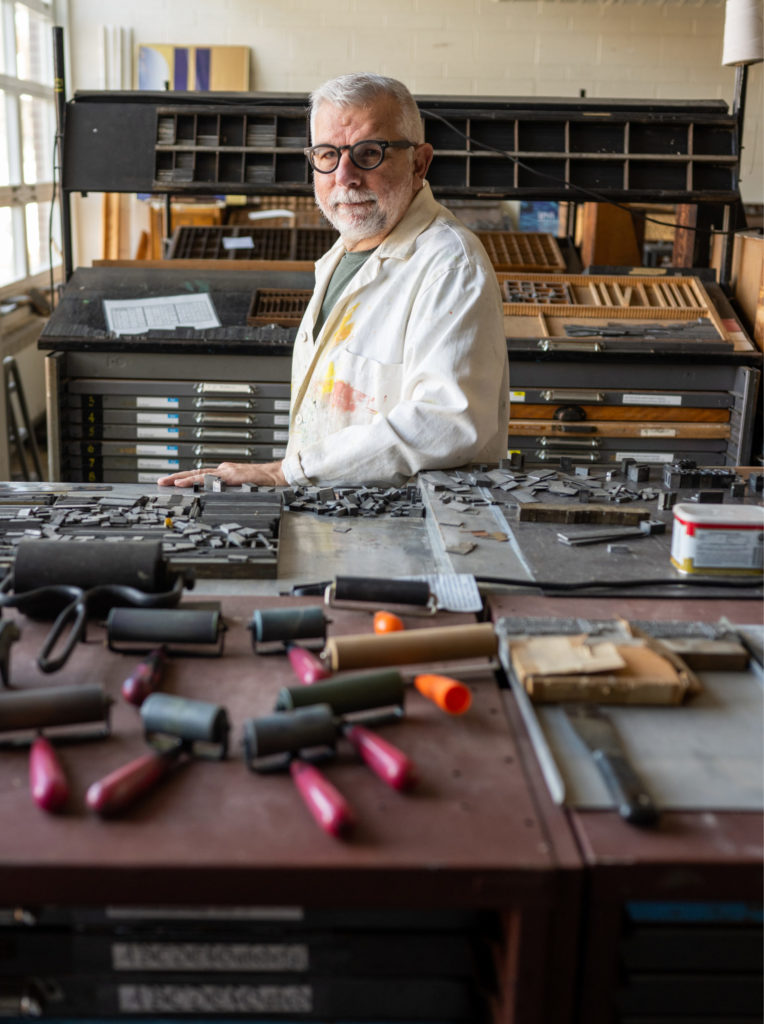
The Don E. Adleta TypeShop and Bindery is named in honor of Don Adleta, BFA ’75, professor emeritus of graphic design in Ohio University’s College of Fine Arts. Photo by Ben Wirtz Siegel, BSVC '02
“People were burning wood type to heat their shops,” Adleta recalls. “They’d melt down metal type to sell as scrap … dump machines off loading docks. The ones that were saved are precious items, preserved by someone who saw the value in letterpress.”
As a student of Adleta’s and a graduate of OHIO’s inaugural MFA in graphic design program established by Adleta, Baker worked in the college’s old typeshop. There, as Adleta puts it, “a fire was ignited in him. From when he was a student until now, anything we’ve collected is because of him.”
Today, Baker has taken up the charge. When not lecturing in Chillicothe and Athens as assistant professor of design, Baker, who helped build and now manages the TypeShop and Bindery, is busy securing new donations and partnerships.
“Typesetting and bookbinding provide a profound physical understanding of design as real visual space, not just a hypothetical—and it is a profound experience,” Baker says.
As Baker—and many others—can attest, this practical exercise in industry heritage offers both inspiration and competitive edge.
The building blocks of design
Michael Jung, BFA ’16—now a digital product designer at Peloton—remembers the first time he walked through the old typeshop.
“That was the first time I really saw typography not as words, but as shapes … like, ‘Oh, I need to stop and look around at things—not as they are, but as they could be,’” he says.
This shift in perspective extends far beyond graphic design. Last fall, Baker invited Associate Professor Dr. Joe McLaughlin’s English class to print “The Red Wheelbarrow,” a poem by William Carlos Williams, on the TypeShop and Bindery’s Vandercook letterpress. Watching the verse printed by a device its author might have used brought new life to their studies and inspiration when the students returned to the facility to print and bind poems they’d written into a booklet.
Baker plans to adapt his popular Letterpress and Bookmaking course to a two-week, four-credit summer workshop. The printshop equivalent of education abroad, the course includes lessons in various methods of bookbinding and a final project challenging students to reinvent what a book can be.
For Jung, the course offered a master class in creative problem solving. He wanted to convey personal trauma through a clean aesthetic—without sharing the actual story. When he learned about the University’s Braille printer, Jung fell in love with the crisp square ratio of its paper, “all perforated and connected like an accordion.” His final book, Tactile Memories, included elegant die-cut Roman letter forms, shadow play and Braille, simultaneously expressing and obscuring deeply personal content his classmates could literally feel without understanding.
Opoku’s final project featured an interactive wooden puzzle book resembling a Rubik’s Cube. Each side—or “page”—depicts an Adinkra symbol from the Ghanaian ideographic writing system. While the book easily unfolds into serpentine form, its reconstruction takes considerable effort.
“The construction of this book was a struggle requiring many calculations,” Opoku says, noting the training he received in the School of Art + Design’s woodshop. “This represents the struggle my culture has gone through to evolve and rebuild this kind of language that faced colonial suppression.”
This return to the origins of graphic design requires slower pace and fresh eyes, helping Opoku “realize all that I was losing in the digital space by clicking a button … It helps me understand where the current understanding of graphic design evolved from, and also where it is going.”
In his work as a web page designer, Jung applies letterpress and bookmaking lessons every day. “That felt appreciation for something as permanent as cutting a page helps me become a more thoughtful, decisive designer,” he says.
A larger typeshop and bindery means more multidisciplinary offerings—from Adleta’s course on the history of the book to Baker’s recently approved agency course, which allows graphic design students to complete professional projects for community nonprofits.
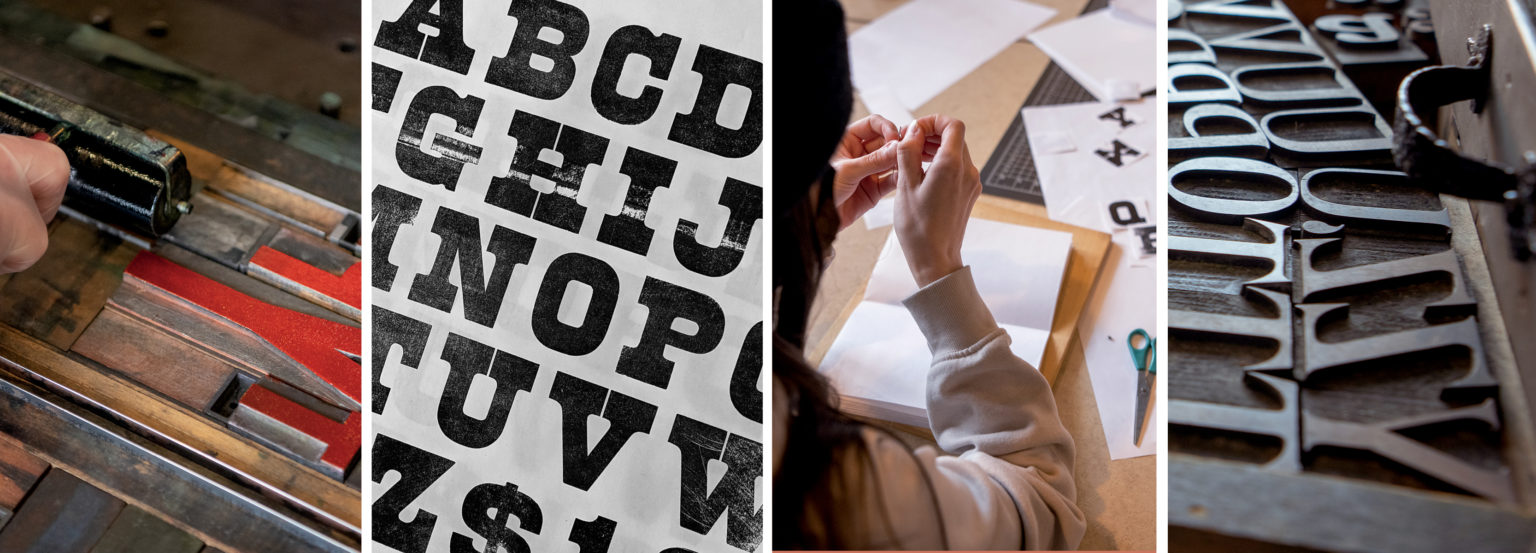
Enriching curriculum, community and industry
Adleta and Baker’s vision for this new space covers curriculum and community, expanding opportunities for OHIO students, visitors across the Southeast Ohio region, and industry scholars both nation- and worldwide.
At the facility’s ribbon-cutting in October, Adleta invited guests to “imagine a group of enthusiastic, senior-citizen typophiles descending on Athens to print their most cherished thoughts.” The typeshop’s senior outreach will explore partnerships from Athens’ Dairy Barn Arts Center to Boston’s Road Scholar® program.
In November, Baker led a hands-on letterpress activity for prospective students at the 2021 Experience the Arts Day. He expected the usual five or six curious souls to wander in.
“I was getting the big Vandercook ready. Then I said, ‘Ok, let’s begin.’ I looked up, and there must have been 50 people there!” Baker says. “There’s a heightened demand right now for real-life, real-time engagement.”
The Adleta TypeShop and Bindery delivers. In addition to programming for families and older adults, the facility will host art teachers attending the June Ohio Arts Education Association Summer Symposium being held in Athens, plus annual summer training for educators.
And when Adleta and Baker talk about enriching the industry, they’re thinking bigger than regional symposiums or even international conferences.
Baker is helping to establish an American Type Founders (ATF) Institute dedicated to preserving and reviving historical type and equipment from ATF, once the world’s leading foundry.
In the 1980s, typecaster Gregory Walters of Piqua, Ohio, purchased all the ATF equipment he could find. In recent years, Baker has learned typecasting under Walters and revived historic typefaces—including those used in the first printed version of the Declaration of Independence.
Baker and Adleta also have elaborate ideas for a typeshop and bindery museum in Athens. They envision an interactive, virtual “trail of type, papermaking and bookmaking,” digitally connecting OHIO and Athens to partners across the Southeast Ohio region—from the Mountain House in Chillicothe to presses in Columbus—and beyond.
“We’re ever-expanding, uncovering new lines of growth,” Adelta says. “I think that is a really important part of our story: That this is just the beginning of what’s possible.”
Last spring, Ohio University’s School of Art + Design hosted the first-ever exhibition to celebrate the careers and work of OHIO’s alumni graphic designers. Explore that exhibit virtually and hear from and about OHIO alumni designers whose work spans everything from Yankee Stadium and the Mississippi Civil Rights Museum to the set design for Lady Gaga and the cover of Prince’s Purple Rain album.
Featured images: Ben Wirtz Siegel, BSVC '02. TypeShop experience by Akbar Sultanov


